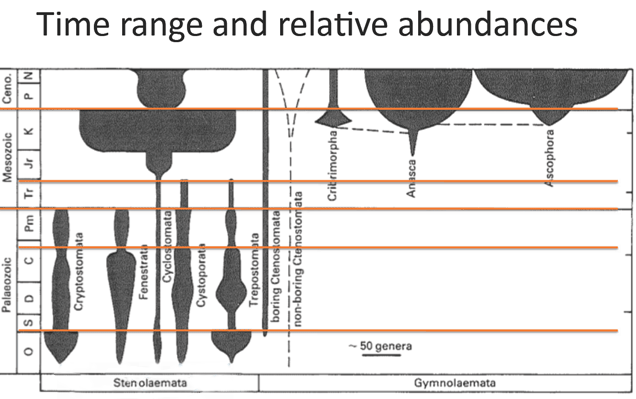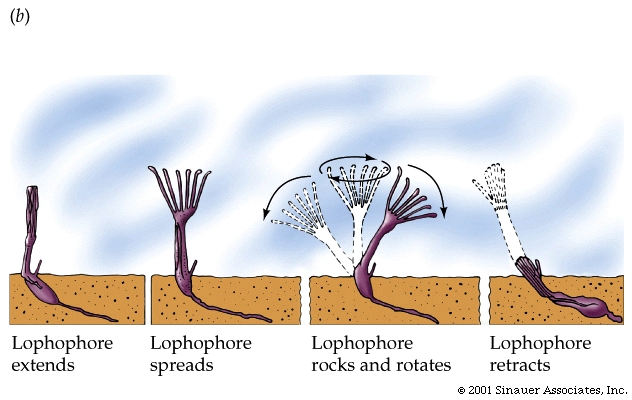
A lophophore is an upstream collecting system for suspension feeding. Its ciliated tentacles form a funnel with the small end surrounding the mouth and the large end opening to the water. Lateral cilia on the sides of the tentacles create a flow of water. Suspended particles strike the tentacles and become entangled in mucus and moved the mouth by frontal cilia. Lophophore is usually extended by increaing the hydrostatic pressure in the main body cavity. The area of the main body cavity is decreased by circular muscles or in others, septa attached to the exoskeleton are pulled inward by transverse muscles. The lophophore is retracted by muscles.

The body divided into two regions, each with a coelomic cavity. Tentacles were used as gills primitively. They are circular in cross section and the coelom extends into them . This make this clades eucoelomic.
The body is converted to horseshoe or spiraled to increase number of tentacles and surface area for food capture and respiration. In general, ammonia is lost across body surface
Most have a pair of metanephridia. A hemal system can be present and some forms even have a heart and blood. There is an nervous system with a nerve ring although sense organs are poorly developed.
http://www.biology.ualberta.ca/courses.hp/zool250/animations/Excretion.swf
All forms of reproduction are observed Radial cleavage is typical and development usually indirect with pelagic larvae. The fate of the blastopore is unclear, sometimes becoming the mouth and sometimes closing.
Bryozoa:
The Bryozoans (Ectoprocts, anus outside tentacles) are an clade (phylum) of microscopic to small animals. All but one species are colonial.
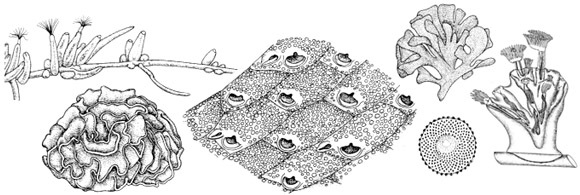
Colonies of Bryozoans are started by a single individual, which after its larval existence settles onto a substrate and after a little growth begins to reproduce asexually (by budding). Thus a colony is composed entirely of clones (genetically identical individuals) of the first animal which is called the ancestrula. Colonies can grow quite quickly if the circumstances are right. A colony was observed was observed to grow from a single ancestrula to a colony of 38,000 individuals in just five months. It was 12 cms or 5 inches across by this stage.
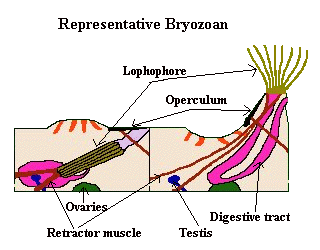
The individual animals within a colony are called zooids. Each zooid secretes and lives inside a non-living case called a zooecium (pl. zooecia). These zooecia come in many different shapes and are interconnected in different ways depending on their shape. The walls of these zooecia are strengthened with a variety of substances depending on species, normally this is either calcium carbonate, chitin or a mixture of both. Each zooecium has a hole at the top called an orifice through which the animal can extend its ring of tentacles or lophophore when it is feeding. In some species this orifice can be sealed shut by a sort of door called an operculum.
Within a colony the individual zooids are not completely isolated. Each zooid is connected to its nearest neighbors by a strand of protoplasm. this enables nutrients to be transferred from one individual to another. This in turn allows some zooids to adopt morphologically distinct forms.
Common forms:
Autozooids :- Specialised in feeding or in collecting food.
Varicularia:- These have developed a form like a birds beak and they bite anything that comes too close to the colony. Thus they serve to protect the colony from some of its enemies. They also hold onto any small animals they bite until they die and start to disintegrate. Once the body is disintegrating the particles can be collected by the feeding zooids.
Vibracula:- In this form the operculum is modified into a long thin bristle which can be swept backwards and forwards over the colony. This helps prevent detritus building up on the colony and deters other sedentary animals from settling on the colony.
Ooecia:- These are zooids specialised for reproductive activities, they act as brood chambers, producing and holding safe the eggs until they are ready to hatch.
Also there are individuals that serve as stolons, holdfasts and attachment disks. Their polymorphisms are comparable to those we have seen in Hydrozoan colonies.
They have a U-shaped gut and a lophophore of ciliated tentacles that generate a water current and trap small particles of food on a constantly moving stream of mucous. This mucous stream moves down the tentacles and into the digestive tract, taking anything it has caught with it. The digestive tract consists of an oesophagus, a stomach and an intestine which terminates in an anus. The base of the lophophore is circular in marine forms and horse-shoe shaped in fresh-water forms. They are sometimes called ectoprocts, because the anus opens outside of the lophophore.
Because of their relatively small size Bryozoans have no need of a hemal system. Gaseous exchange occurs across the entire surface of the body, but particularly through the tentacles of the lophophore. Bryozoans also have no special organs for the excretion of metabolic wastes. The nervous system is composed of a single bilobed ganglion at the base of the lophophore near the pharynx. This has a number of nerves leading off from it to the internal organs and muscles, it also connects to a nerve net in the body wall and the nerve ring which supplies nerves to the tentacles of the lophophore.
All Bryozoans are hermaphrodite, although individual zooids may be male or female. Colonies grow by means of asexual budding of individuals. New colonies are usually started by individuals resulting from sexual reproduction. The exception to this is that in a few species, if the colony gets too big it will divide in two. One half will then move a small distance away from the other before settling down to life again.
Sexual reproduction involves the release sperm through the tips of the tentacles. Eggs come in two forms, they are either small and also released into the water where they are eventually found by a sperm. Or else they are larger and retained within the animals body, in ooecia in those forms that have them. These are then fertilized by sperms that are brought in on the feeding current. In this later case the larvae are released after they hatch. These larvae can swim but do not feed. They swim towards the light at first then after a few hours they swim away from the light, down to the sea floor to look for a suitable substrate to start a new colony on.
Freshwater species also reproduce by producing overwintering capsules called 'statoblasts'. These desiccation can withstand extreme cold and desiccation. Once the temperature rises, or the water returns the statoblasts germinate into new ancestrulas. As many as 800,000 per metre squared have been recorded for mile on mile along the shores of lake Michigan, USA.
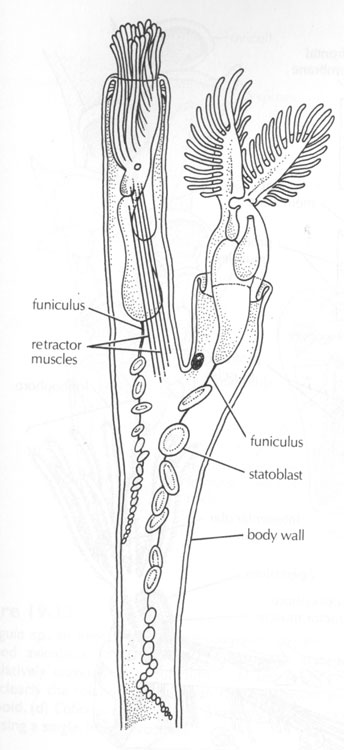
They are well preserved in the fossil record because of their hard skeletons and we know they have been around since the Ordovician era (500 MYA). Molecular data, almost exclusively obtained from 18S rRNA sequences, place the bryozoans loosely within the ‘Lophotrochozoa’. Phoronids and brachiopods, our next clades to be examined, are included in this group but apparently are no more closely related to Bryozoans than other Lophotrochozoans. They have suffered major setbacks in diversity with every major extinction and most of the recent forms are relatively new clades.
